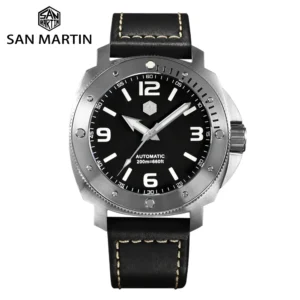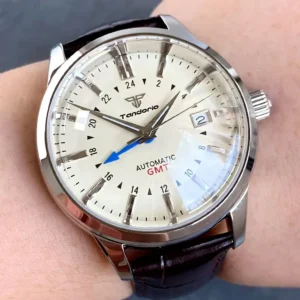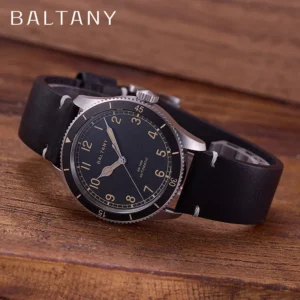Introduction: The Enduring Allure of Naturally Patinated Bronze Watches
Bronze watches stand apart in the world of horology as true “living metals” – timepieces that transform and evolve alongside their wearers. Unlike stainless steel or gold watches that remain relatively unchanged over decades, bronze timepieces undergo a fascinating metamorphosis called patination. This natural aging process creates a distinctive surface transformation that makes each bronze watch uniquely personal to its owner.
The use of bronze in watchmaking draws inspiration from maritime history, where the metal’s resilience against corrosion made it ideal for nautical instruments and diving equipment. Though relatively new to modern watchmaking compared to traditional materials, bronze has captured the imagination of watch enthusiasts precisely because of its dynamic nature. The history of dive watch engineering reveals how bronze has transitioned from practical marine applications to sought-after luxury timepieces.
What makes bronze watches truly special is their ability to:
- Develop a unique patina based on the wearer’s lifestyle and environment
- Change color from bright golden hues to rich browns, greens, and blues
- Create a visual record of adventures and experiences
- Establish a deeper connection between timepiece and owner
The typical bronze watch case materials contain copper-tin alloys, with some manufacturers using proprietary blends that patinate at different rates and with distinct characteristics. From bright and shiny when new to rich with character after months of wear, the journey of a bronze watch represents something increasingly rare in our disposable culture – an object that improves with age and use rather than deteriorating.
The Science Behind Bronze Patina: Understanding the Transformation
What is Patina?
Patina is the naturally occurring protective layer that forms on bronze surfaces when exposed to air, moisture, and other environmental elements. Unlike rust on iron or steel, which is destructive and continues to eat away at the metal, patina is actually beneficial to bronze. It creates a stable surface barrier that protects the underlying metal from further oxidation.
This natural surface transformation represents a kind of “fingerprint” that makes each bronze watch unique. No two watches will ever age exactly alike, even if they’re identical models from the same production batch. The formation of bronze watch patina follows predictable chemical principles but results in unpredictable and beautiful variations.
Much like how fine leather develops a rich character or how premium denim fades in patterns unique to its wearer, bronze patina tells a story. The difference is that while leather and denim eventually wear out, bronze patina continually evolves while protecting the metal beneath.
The Chemical Process of Bronze Patination
The patination of bronze watches is fundamentally a series of chemical reactions between the metal’s surface and the environment. Bronze itself is primarily an alloy of copper (usually 88-95%) and tin (5-12%), with the copper component being responsible for most of the visible aging process.
When exposed to oxygen in the air, the copper begins to oxidize, forming a thin layer of copper oxide (Cu₂O). This initial reaction creates the first subtle darkening of the bronze surface. As exposure continues, especially when moisture is present, copper hydroxides and eventually copper carbonates form on the surface, producing the characteristic green-blue patina known as verdigris.
The basic chemical progression works like this:
- Fresh bronze has a bright, golden appearance
- Copper in the alloy reacts with oxygen to form copper oxides (brown to reddish hues)
- With moisture and carbon dioxide exposure, copper carbonates form (greens and blues)
- Additional elements like sulfur can create copper sulfides (darker browns and blacks)
What makes bronze patination fascinating is how various factors affect its speed and characteristics. The exact composition of the bronze alloy, environmental conditions, and even the oils from your skin all play crucial roles in determining how your watch will age over time.
Factors Influencing Your Watch’s Unique Patina Story
The Wearer’s Contribution: Skin Chemistry and Lifestyle
Your body chemistry plays a surprisingly significant role in how your bronze watch ages. Each person’s skin has a unique pH level and produces different amounts of oils and sweat, all of which interact with bronze in distinct ways:
- Higher skin acidity tends to accelerate patina development
- Natural skin oils transfer to the watch case during wear, affecting oxidation patterns
- Sweat contains salts and other compounds that create unique chemical reactions with bronze
- Areas of the watch in frequent contact with skin (caseback, sides) develop patina differently than exposed areas
Your lifestyle and occupation also dramatically influence how your watch ages. Someone working in an office environment will develop a much different patina than a person who spends time outdoors or near the ocean. A watch worn daily shows wear patterns and patina development in high-contact areas like the bezel edge and crown, while protected areas like recessed engravings may maintain different coloration.

Even the frequency with which you wear your watch matters—a daily wearer develops more consistent patina than one worn occasionally. This is part of what makes bronze watches so personal; they literally bear the chemical imprint of their owner’s life and habits.
Environmental Exposure: The World Your Watch Experiences
The environments your bronze watch encounters dramatically influence its aging process, creating distinctive patterns and colors based on where you live and travel:
| Environment | Patina Characteristics | Development Speed |
|---|---|---|
| Coastal/Marine | Blue-green hues, more pronounced texture | Very rapid (days to weeks) |
| Urban/City | Darker tones, potentially uneven patterns | Moderate (weeks to months) |
| Dry/Desert | Slower development, more browns than greens | Slow (months) |
| Indoor/Climate Controlled | Subtle, even development with minimal color variation | Very slow (months to years) |
| Tropical/Humid | Rich, varied patina with pronounced color | Rapid (weeks) |
Temperature also influences patination rates, with warmer environments generally accelerating the chemical processes. A watch worn in Miami will develop patina much faster than an identical model worn in Seattle or Denver.
Beyond natural environments, your watch encounters numerous substances in daily life that affect its aging. Chlorinated pool water, soaps, lotions, and even cooking ingredients like lemon juice or vinegar can all interact with bronze. These exposures contribute to what makes rugged watches in extreme conditions develop such character—each environment leaves its mark on the timepiece.
Bronze Alloy Composition: The Foundation of Patina
Not all bronze watches age the same way because not all bronze is created equal. The specific alloy used in a watch case fundamentally determines how it will patinate:
| Bronze Alloy Type | Composition | Initial Color | Patina Characteristics |
|---|---|---|---|
| CuSn8 (Marine Bronze) | 92% copper, 8% tin | Warm reddish-gold | Rich, varied patina with good depth; tends toward browns and greens |
| CuAl (Aluminum Bronze) | Copper with aluminum | Brighter gold tone | More resistance to patination; develops more subtle coloration |
| Custom Alloys | Varies by manufacturer | Varies | Some brands create proprietary alloys for specific patina characteristics |
The alloy composition affects not just the color development but also the texture of the patina and how quickly it forms. Some watch manufacturers deliberately choose their bronze alloys based on the patination characteristics they want to achieve.
Our bronze automatic watches collection features various alloys selected for their excellent aging properties and structural integrity, allowing for patina development while maintaining case strength and durability.
The Visual Journey: Colors and Textures of Aging Bronze
The Patina Spectrum: A Journey Through Hues
The visual transformation of a bronze watch follows a fascinating progression that unfolds over months and years:
Initial State (New): Fresh bronze has a bright, polished appearance ranging from salmon-pink to golden yellow depending on the alloy. The surface is reflective and uniform, almost resembling a gold watch at first glance.
Early Development (Weeks 1-4): The first change most owners notice is a general darkening and dulling of the reflective surface. The bright gold begins to deepen to a warmer tone, and the high polish starts to become more subdued. This stage often produces subtle amber and honey tones.
Mid-Stage Development (Months 2-6): As patina continues developing, the watch typically takes on rich chocolate brown hues with areas of russet and darker brown. This stage often shows the most dramatic week-to-week changes, especially for watches worn daily.
Mature Patina (6+ months): With continued exposure and wear, bronze watches can develop an impressive spectrum of colors including:
– Deep chocolate browns
– Reddish copper tones
– Forest and olive greens (especially in humid environments)
– Hints of blue-green (common near oceans)
– Areas of purplish-brown in recessed areas
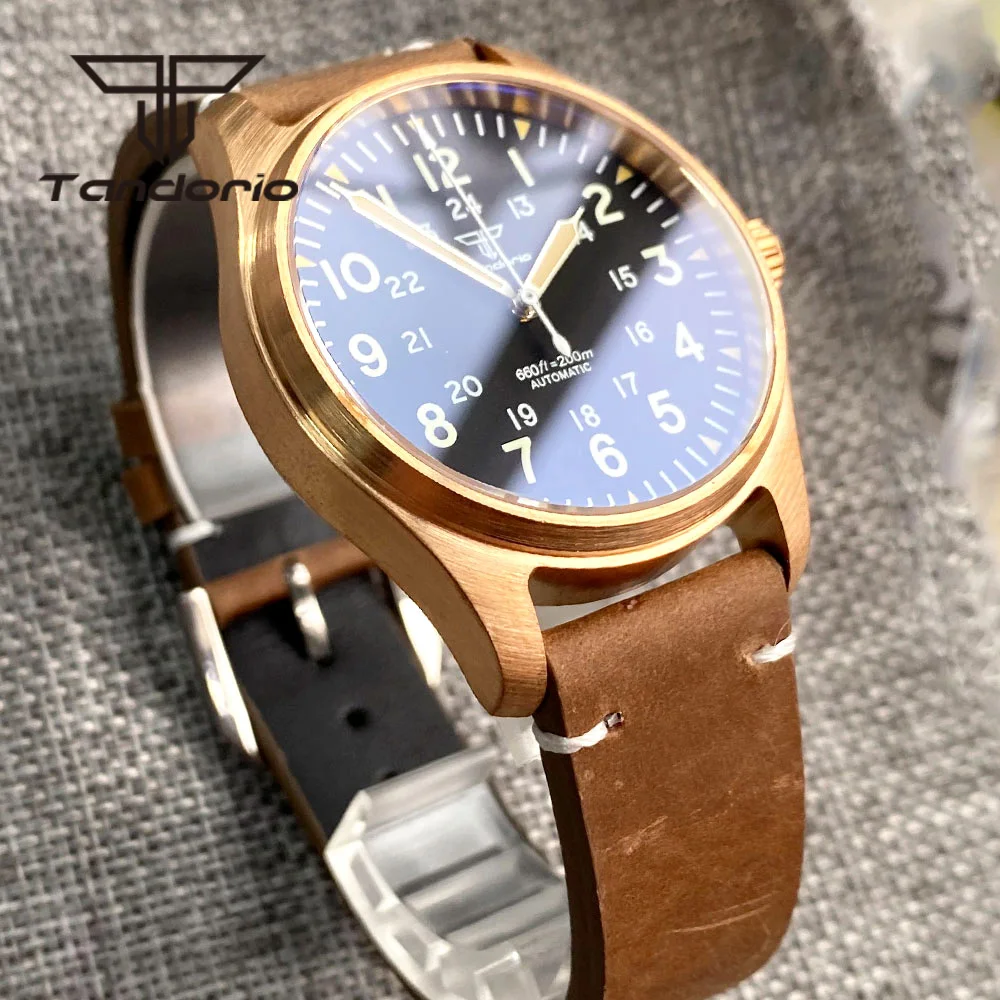
Our automatic dive watches in bronze showcase this evolution particularly well, as their larger case sizes provide more canvas for patina development, and their water exposure often accelerates the process in interesting ways.
Textural Transformation: Beyond Color Changes
While color changes are the most obvious aspect of patination, the texture of your bronze watch also undergoes a significant transformation:
- The initially smooth, polished surface gradually takes on a more matte appearance
- Microscopic pits and texture develop across the surface, creating visual depth
- High-contact areas like the bezel edge may remain smoother than recessed areas
- Protected areas like engraving and between lugs develop deeper patina with more texture
- Areas exposed to friction (like where the watch slides under a shirt cuff) develop unique wear patterns
This textural evolution is what gives aged bronze watches their distinctive character. Unlike the uniform surface of steel or gold, patinated bronze has visual depth that catches light differently across its surface. The tactile experience changes too—many bronze watch owners describe how their timepiece feels warmer and more organic in hand after developing patina compared to the cool, metallic feel when new.
The Value of Patina: Protection and Character
The Protective Layer: Nature’s Shield for Your Timepiece
The patina that forms on bronze watches isn’t just aesthetically interesting—it serves an important protective function. This natural oxidation layer creates a barrier that actually shields the underlying metal from further corrosion or damage.
Once a stable patina forms, it significantly slows additional oxidation, essentially “sealing” the bronze beneath. This self-limiting nature of bronze oxidation explains why ancient bronze artifacts can survive thousands of years while iron objects from the same period completely deteriorate.
This protective quality represents one of bronze’s most remarkable characteristics as a watchmaking material. While stainless steel resists corrosion through its chromium content, bronze actively develops its own defense mechanism. The natural patina layer is:
- Chemically stable and self-regulating
- Strongly adhered to the base metal (unlike rust that flakes away)
- Capable of reforming if damaged or partially removed
- Protective against many environmental contaminants
The evolution of dive watch technology has embraced this property, with bronze becoming particularly popular for serious underwater timepieces precisely because of its self-protecting nature in marine environments.
Aesthetic Appeal and Character Development
Beyond protection, patina adds tremendous aesthetic value to bronze watches. Many enthusiasts specifically choose bronze for its ability to develop visual character that stainless steel simply cannot match:
- Patina adds depth and visual interest that enhances watch design
- The changing appearance creates a “living” quality that evolves over time
- Aging highlights design elements like bezel markings and case details
- The warmth of patinated bronze complements strap materials, especially leather and canvas
Bronze watches with substantial patina often draw attention and conversation in ways that even precious metal watches don’t. Their organic, lived-in appearance speaks to authenticity and personal history rather than mere luxury.
The Personal Chronicle: Your Life Written in Bronze
Perhaps the most meaningful aspect of bronze patina is how it creates a permanent record of your experiences with the watch. Every adventure, every environment, and every moment spent wearing your bronze timepiece contributes to its unique appearance.
A well-worn bronze watch becomes almost like a journal—the patina patterns might show the effects of that sailing trip you took, the summer spent outdoors, or the years working in a particular environment. This physical connection between life experiences and the watch’s appearance creates a sentimental bond unlike any other horological material.
For many collectors, this is the philosophical appeal of rugged automatic watches in bronze—they’re not merely accessories but companions that physically transform through shared experiences. While photographs capture moments in time, a patinated bronze watch embodies the accumulated history of your journeys.
Distinguishing Natural Patina from “Bronze Disease”
What is Bronze Disease?
While natural patina is beneficial and desirable, bronze can occasionally develop a problematic condition known as “bronze disease.” This destructive form of corrosion differs significantly from normal patination and can potentially damage your timepiece if left unchecked.
Bronze disease occurs when chloride ions (often from saltwater exposure) catalyze an ongoing chemical reaction that doesn’t stabilize like normal patina. Instead, it continues to convert the bronze into copper chloride compounds that perpetuate the corrosion cycle.
Warning signs of bronze disease include:
- Powdery, light green spots that appear to be “growing”
- Areas that feel rough, flaky, or can be brushed away
- Pitting that continues to worsen rather than stabilize
- Unusual or inconsistent coloration compared to the rest of the watch
Unlike the slow, even development of natural patina, bronze disease tends to appear suddenly and spreads rapidly. While quite rare in modern watches due to improved alloys and manufacturing processes, it’s still something bronze watch owners should be aware of.
Identifying the Difference and Prevention
Understanding the differences between healthy patina and problematic corrosion helps ensure your bronze watch ages beautifully:
| Characteristic | Healthy Patina | Bronze Disease |
|---|---|---|
| Texture | Generally smooth, uniform | Powdery, crusty, or flaking |
| Color | Browns, blues, greens in even patterns | Bright, artificial-looking green spots |
| Development | Slow, gradual changes | Appears suddenly, spreads quickly |
| Surface Integrity | Maintains original contours | May show pitting or deterioration |
To prevent bronze disease and ensure healthy patination:
- Rinse your watch with fresh water after exposure to saltwater
- Dry thoroughly, especially around crown and case joints
- Avoid leaving your watch in high-humidity environments when not wearing
- Consider occasional gentle cleaning with mild soap and water
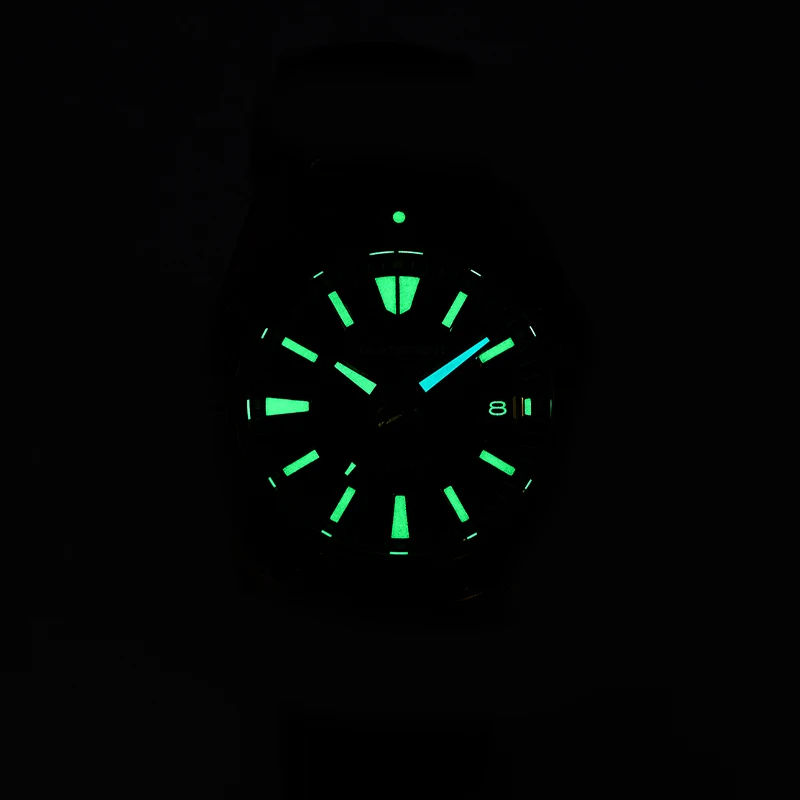
With proper care, modern bronze watches are highly unlikely to develop bronze disease. The stable patina that naturally forms actually helps prevent this condition by creating a protective barrier against the elements.
Caring for Your Aging Bronze Timepiece
General Maintenance: Preserving the Patina
Proper care allows your bronze watch to develop character while maintaining its functional integrity. The goal is to support the natural patination process while preventing damage to the watch mechanism and seals.
Follow these simple steps for routine maintenance:
- Wipe the watch case periodically with a soft, dry cloth to remove dust and skin oils
- For more thorough cleaning, use plain water on a soft cloth, avoiding harsh chemicals
- After water exposure (especially saltwater), rinse with fresh water and dry thoroughly
- Pay special attention to drying the areas around the crown, pushers, and case back
- Store in a well-ventilated area when not wearing (avoid airtight containers which can trap moisture)
Remember that the movement inside requires separate maintenance according to the manufacturer’s recommendations. The bronze watch care guide provides detailed information on maintaining both the case and movement for optimal performance and longevity.
Products to avoid on bronze watches include:
* Harsh chemical cleaners
* Abrasive polishing compounds (unless intentionally removing patina)
* Chlorine-based cleaners
* Ultrasonic cleaners (which can damage gaskets)
Resetting or Removing Patina: Restoring the Original Shine
While many enthusiasts cherish the patinated look, others prefer to occasionally reset their bronze watch to its original appearance. This is entirely a matter of personal preference—there’s no “right” approach to patina management.
If you wish to remove patina and restore the original shine, several methods are effective:
Lemon Juice Method:
1. Mix equal parts lemon juice and warm water
2. Dip a soft cloth in the mixture and gently wipe the bronze surfaces
3. For stubborn patina, let the lemon juice remain on the surface for 1-2 minutes
4. Rinse thoroughly with clean water and dry completely
5. The watch will begin to patinate again immediately after cleaning
Baking Soda Paste Method:
1. Create a paste using baking soda and water
2. Apply to the watch case with a soft cloth using gentle circular motions
3. Rinse thoroughly and dry completely
Commercial bronze cleaners designed for jewelry can also be effective, but always check that they’re safe for use on watches with gaskets and seals.
After removing patina, the bronze will quickly begin to oxidize again, typically darkening within days. Many owners find that the second patination process often produces more even, attractive results than the first.
Managing Patina Development: Control Your Watch’s Evolution
For those who want some control over their watch’s patination process without completely removing the existing character, several approaches can help manage the aging process:
| To Encourage Patina | To Slow Patina Development |
|---|---|
| Store in a humid environment | Apply a thin coat of Renaissance wax |
| Create a salt water vapor environment (not direct contact) | Use watch-safe mineral oil on the case |
| Wear frequently, especially during physical activity | Store in a dry environment with silica gel |
| Expose to air but avoid direct handling | Rotate wearing with other watches |
Some owners use selective cleaning to create intentional patina patterns, such as keeping the bezel dark while maintaining brighter case sides. This personalized approach allows you to guide your watch’s aging process rather than simply letting nature take its course.
Military Inspired Automatic Watches, Rugged Automatic Watches, Tactical Automatic Watches
Price range: $852.14 through $994.60 Select options This product has multiple variants. The options may be chosen on the product pageAutomatic Chronograph Watches, Classic Style Dive Watches
$3,053.06 Select options This product has multiple variants. The options may be chosen on the product pageBronze Automatic Watches, Military Inspired Automatic Watches, Professional Spec Dive Watches
Price range: $1,442.21 through $1,442.82 Select options This product has multiple variants. The options may be chosen on the product pageProfessional Spec Dive Watches, Titanium Automatic Watches
$574.74 Select options This product has multiple variants. The options may be chosen on the product pageClassic Automatic Dress Watches, GMT Automatic Watches, GMT Dive Watches
Price range: $468.93 through $552.94 Select options This product has multiple variants. The options may be chosen on the product pageClassic Pilot Watches, Military Inspired Automatic Watches
$561.00 Select options This product has multiple variants. The options may be chosen on the product page
Natural vs. Forced Patina: The Enthusiast’s Dilemma
While natural patination takes time, some watch owners prefer to accelerate the process through various “forced patina” techniques. These methods use chemicals or environmental exposure to quickly achieve what would naturally take months or years.
Common forced patination methods include exposure to ammonia vapors, sulfur compounds, or specialty patination solutions designed for bronze art. These can create dramatic effects in hours rather than months.
The debate between natural and forced patina centers around several considerations:
Natural Patina Benefits:
* Develops organically with true connection to wear and experiences
* Creates more subtle, nuanced coloration with greater depth
* Tends to be more stable and less likely to flake or wear unevenly
* Represents the authentic journey of the watch and owner
Forced Patina Benefits:
* Provides immediate gratification
* Allows for specific color effects not easily achieved naturally
* Can create more dramatic or artistic appearances
* Bypasses the sometimes awkward “early patina” stage
Many enthusiasts feel that natural patination, while requiring patience, ultimately creates a more authentic connection to the timepiece. Others appreciate the ability to customize their watch’s appearance through forced techniques.
The longevity of automatic watches is measured in decades, giving natural patina plenty of time to develop its full character, which may influence your decision about whether to force the process or enjoy the gradual evolution.
Embracing Your Bronze Watch’s Unique Journey
The natural aging of bronze watches represents something increasingly rare in our modern world—an object that doesn’t deteriorate with use but instead develops greater character and individuality. Each mark, color shift, and textural change tells part of your story and creates a deeply personal timepiece.
The beauty of bronze patina lies in its:
* Uniqueness—no two watches will ever age exactly alike
* Personalization—your specific habits and environments create your watch’s appearance
* Evolution—the watch continues changing subtly throughout its lifetime
* Protection—the patina serves a functional purpose while adding visual interest
Whether you’re drawn to the rich history of traditional watchmaking materials, the practical benefits of bronze’s corrosion resistance, or simply the aesthetic appeal of a naturally aging timepiece, bronze watches offer something special in the world of horology.
For those seeking timepieces with authentic character, our collection of automatic field and military watches includes bronze models specifically selected for their excellent patination properties.
A bronze watch is more than just a timekeeping instrument—it’s a companion that evolves alongside you, recording your experiences in its very surface. In an age of disposable products, there’s something profoundly satisfying about owning an object that doesn’t simply wear out but instead grows more distinctive and personal with every passing day.


